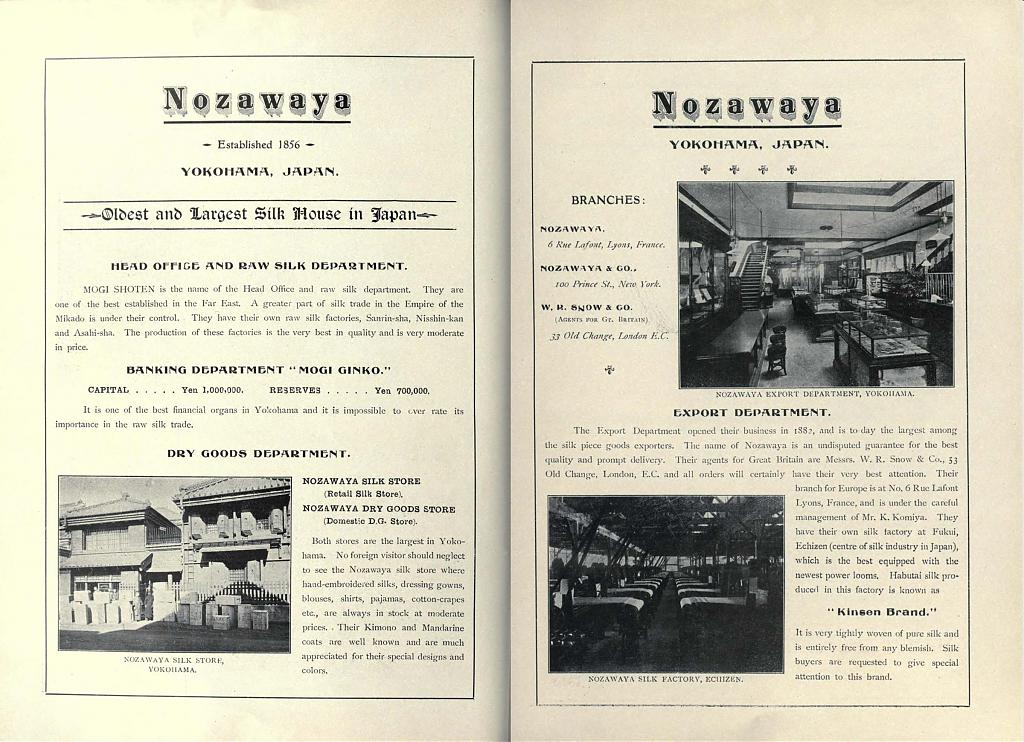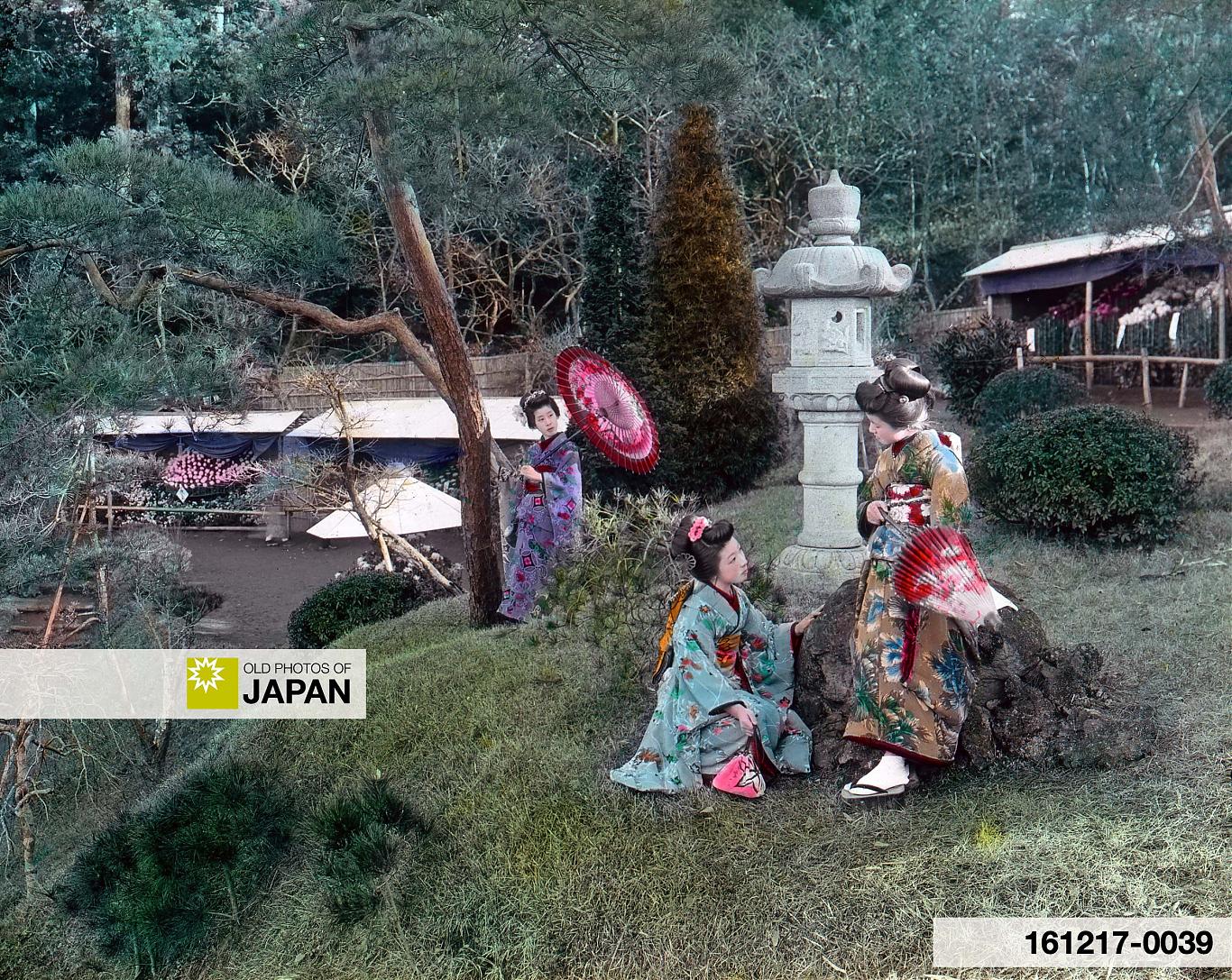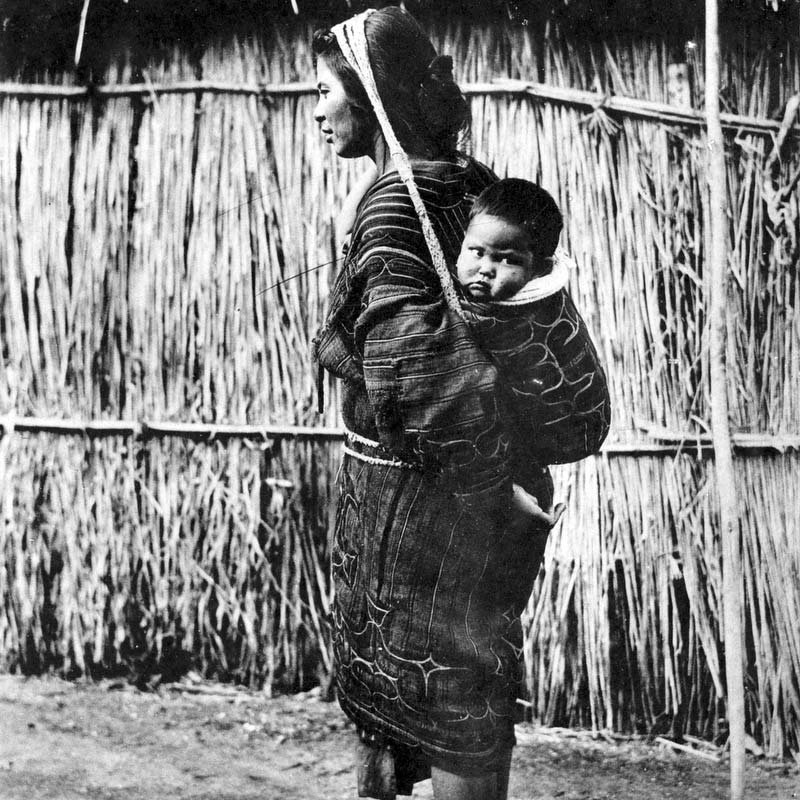Three maiko (apprentice geisha) posing next to a stone lantern at a Japanese garden.
Japanese photographer Nobukuni Enami photographed this lovely scene of three maiko in gorgeous kimono at Yokohama’s famed Nozawaya Garden.
This private garden was on the grounds of a villa (別荘庭園) in Nogeyama (野毛山) owned by the Mogi family (茂木家). This rich merchant family ran, amongst other businesses, the successful Nozawaya department store.
The company was launched in Yokohama in 1859 as a silk store, known as the Nozawaya Silk Store (野澤屋絹物店).1 It was located on No. 30 Benten-dori Nichome in Yokohama, for many decades the most important shopping street in the city.
Over the years, the family expanded into banking, real estate, general retail and other industries. The family was extremely successful, the silk business for example had stores in Yokohama, New York, Lyons, Paris and London.

The garden, popularly known as the Nozawa or Nozawaya Garden (野沢庭園、野沢屋庭園) was opened to the public twice a year. People would line up to admire the plum blossom in spring and the chrysanthemums in autumn.


In 1892 (Meiji 25), British horticulturist James Herbert Veitch (1868–1907) visited the garden. He described his impressions of the garden as part of a series of letters published in the British horticulture periodical The Gardeners’ Chronicle between March 1892 and December 1894:2
One of the best private gardens in or near Yokohama belongs to a great silk merchant, by name Nozawaya. This garden is only thrown open to the public twice a year, but I managed to get in, and was well repaid. It is a large place, full of little hills, little forests, a little river, very little summer-houses, little paths, all covered with mats, about 2 feet wide, which wind round the little hills, and by little bridges over the little river. The whole big garden is little, and most curious; one cannot help smiling in going round. In this garden are clumps of Cherries, on short stems; from a little hill you look down on them, whilst a few yards’ walk places you beneath them. A path with a Bamboo fence, 1 1/2 feet high, runs round the clump, and leads to another little hill, covered with Pines, 2 to 3 feet high. Clumps of an Abies, which on examination I took to be firma (bifida), are opposite some Bamboos; whilst Retinospora, and some really fine trees (some 50 to 60 feet high) of Cryptomeria japonica were well represented—the only thing large in the garden (for I was a foot higher than anyone in the place). Here I saw many clumps of the yellow-edged Bamboo, the only place in which I have seen it so far; it here possesses the same peculiar characteristic as with us. This garden was very curious, but I believe that of the Prince at Tokio is still more so. To see this I shall require the Ministers’ assistance.

Sadly, the garden didn’t survive the Great Kanto Earthquake. Where once the garden was, now stands the Yokohama Municipal Nogeyama Zoo (野毛山動物園).
Notes
1 Wikipedia, 野澤屋. Retrieved on 2021-12-26.
2 Veitch, James H., The Gardeners’ chronicle : A Traveller’s Notes. Written March 28, 1892, published April 1, 1893. Retrieved on 2021-12-26. In 1896, the letters were privately printed as A Traveller’s Notes.
Published
Updated
Reader Supported
Old Photos of Japan aims to be your personal museum for Japan's visual heritage and to bring the experiences of everyday life in old Japan to you.
To enhance our understanding of Japanese culture and society I track down, acquire, archive, and research images of everyday life, and give them context.
I share what I have found for free on this site, without ads or selling your data.
Your support helps me to continue doing so, and ensures that this exceptional visual heritage will not be lost and forgotten.
Thank you,
Kjeld Duits
Reference for Citations
Duits, Kjeld (). Yokohama 1900s: Maiko at Japanese Garden, OLD PHOTOS of JAPAN. Retrieved on December 12, 2025 (GMT) from https://www.oldphotosjapan.com/photos/854/maiko-at-japanese-garden




glennis
i clicked here to see if this was Sankeien. Too bad this was destroyed. You might consider Sankeien as a topic some time. My Saint Maur classmate’s family was the owner of Sankeien which was also connected to the silk industry. (wasn’t everything?) Beautiful. Went there many times as a child and even recently. It was not far from our house in Negishi/Yamate area
#000714 ·
Kjeld Duits (Author)
@glennis: Yes, I should do something about Sankeien. I only have one image of the garden right now. Will have to find a few more!
Cool, that your classmate’s family owned the garden.
#000715 ·